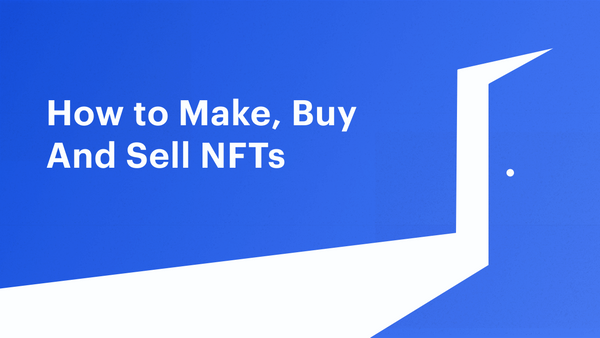Many artists and designers wonder how to make and sell an NFT after seeing how some of those NFT art pieces set records at auctions.
So how can you start selling NFTs? The first step is to research and pick one of the NFT marketplaces. OpenSea is one of them and it also happens to be the largest platform that sells NFT. Consider it an online gallery with digital art, trading cards, and other creative art pieces. It functions similarly to an auction house in that you place bids on products and hope to win, although there is also an option to "buy now" for a set fee.
What Are NFTs and How Do They Work?
Non-fungible tokens (NFTs) have taken over the Internet culture in recent months, and it's easy to see why.
NFTs alter the way creators sell their work online, and gaming companies structure their universes with play-to-earn economies. NFTs are also becoming popular among crypto enterprises to reward loyal customers and promote particular actions.
Recent headlines have established NFTs as a leading use case within the larger crypto movement, with eye-popping sales figures from marketplace Opensea and endorsements from celebrities like Jay Z.
But, exactly, what are NFTs?
In a nutshell, an NFT is a one-of-a-kind digital asset with its ownership recorded on the blockchain. This prevents it from being copied, reproduced, or otherwise duplicated. As a result, the value of NFTs is linked to the concept of scarcity. The fewer of anything there is, the more precious it is.
The majority of NFT projects are now developed on the Ethereum blockchain. Unlike bitcoin, Ethereum has advanced smart contract capabilities that enable the development of NFTs with unique attributes. Newer blockchains like Solana are also rolling out their NFT ecosystems.
On Ethereum, users can purchase and trade NFTs with ETH or other ERC20 tokens like stable coins.
Let's go into everything you need to know about making, selling, and collecting NFTs now that we've covered the basics.
What Kinds of NFTs Are There?

Although it's easy to lump all NFT projects into one category, the reality is that the metaverse's NFT initiatives are almost as diverse as the collecting and gaming markets in the "real" world.
Examples of NFT types include:
- Art
Beeple's $69 million dramatic sales at Christie's auction house last year launched NFTs into the art world. More and more artists rely on Ethereum to make a living by minting and selling NFTs.
Pplpleaser, an NFT artist, was recently featured in a Fortune magazine edition and designed the cover.
- Game Items and Rewards
With games like Axie Infinity attracting hundreds of thousands of gamers and big investors, play-to-earn gaming is swiftly becoming the most obvious NFT use case.
In various game universes, NFTs act as incentives for performing certain actions in the game or to signify some in-game items. For example, players are rewarded for breeding their 'Axies' (which are in fact NFTs) in Axie Infinity by receiving transaction fees when their Axies 'reproduce.'
NFTs are at the heart of the user experience in play-to-earn gaming, a booming sector.
- Music
NFTs are already transforming how musicians and fans create, exchange, and listen to music.
For example, artists can retain total control and ownership of their work when they link music files to NFTs, and they may even use smart contracts to give fans a share of their income. Opuolus is one NFT platform that helps to accomplish this.
Opensea and Rarible also sell NFT music alongside art and collectibles from well-known artists. For example, StrangeLoop Studios and The Weeknd sold an eight-song collaboration.
- Collectibles
Do you remember collecting baseball cards when you were a kid? Do you have any stamps or Beanie Babies?
If you've ever been a collector, you'll immediately understand NFT collectibles. This is because NFT-collectibles are valued depending on the scarcity, like real-world collectibles.
Collectors can check rarity by looking at the number of NFTs in circulation in the smart contract itself or using various tools.
People build NFT collections for all kinds of reasons, but the trend of buying NFTs to use as profile photos or avatars is probably the most obvious.
2. Tokenized- Real-World Assets
Due to the rise in NFTs during the COVID-19 outbreak, tokenized real-world assets have emerged as another potential use case for NFTs.
The concept is straightforward: corporations may break up tangible assets into fractions represented as NFTs, which can subsequently be sold. The holder of an NFT (or a group of NFTs) would get ownership of a proportional fraction of the real-world asset.
Although it is far from the only example, real estate tokenization is likely the easiest use case to get your head around. Investors can purchase fractional shares in property worldwide, similar to a time-share investment.
Is Now the Right Time to Get Into NFT?
The interest in NFTs is still growing. Major organizations and celebrities have published or agreed to release their non-fungible assets, including the UFC and Shawn Mendez. Even Elon Musk's girlfriend Grimes has jumped on the bandwagon, selling roughly $6 million in digital artwork in minutes.
In the first five days of 2022, NFT sales on OpenSea surpassed $700 million, owing to the popularity of the Bored Ape Yacht Club (BAYC) and Mutant Ape Yacht Club (MAYC) collections. With more blockchains working to improve the NFT experience and a growing number of platforms to choose from, now is a great moment to get involved in the industry.
Is It The Best Time to Get Into NFTs?
This probably depends on whether you're an artist or a buyer.
Artists
NFTs may be appealing to you since they enable you to sell work that would otherwise be difficult to market. What will you do, for example, if you come up with an excellent idea for a digital sticker? Is it feasible to sell it on the App Store for iMessage? It's impossible.
Furthermore, with NFTs, you can enable a feature that pays you a percentage of secondary sales of your NFTs. This guarantees that you’ll capture some of the upside if your work will become incredibly popular.
Buyers
NFTs are about self-expression and identity. It was challenging to identify rights and property in the Web2 era because the actual owners of data and platforms are giant tech companies and other enterprises.
With the introduction of Web3, small communities can now form and thrive around shared values. NFTs can be a terrific way to get involved in communities that are important to you while also making a statement about what you believe in. These communities can also help you to learn more about crypto and Web3 in general.
One of the obvious benefits of purchasing art is that it lets you financially support artists you like — this is also true for NFTs. When you buy an NFT, you typically receive some fundamental usage rights, such as the option to share the image online or use it as your profile photo. The pride of ownership comes with holding the NFT, which is recorded on the blockchain.
Are There Any Cons?
Buying NFTs only with the hope to generate huge returns is risky and possibly unwise. Most NFTs will likely decline in value and it's difficult to predict which ones will succeed.
Investing in NFTs that matter to you personally and letting you access communities and causes you to care about is the best way to avoid losing money or making unwise investments.
What Do You Need to Make an NFT?
The following are the elements you’ll need to create your NFT:
Wallet
If you want to make an NFT, the first thing you'll need is a non-custodial wallet.
OpenSea supports the following:
- Zerion Wallet
- Metamask
- Wallet Connect
- Fortmatic
- Trust Wallet
- Portis
- Coinbase wallet
The other major NFT marketplace, Rarible, supports many of the same wallets.
Platform
The primary NFT marketplaces on the market are Opensea and Rarible, as previously stated. Other major NFT marketplaces include Nifty Gateway and Crypto.com, their NFT buying and selling forum.
Many alternative chains, such as Binance, also have their own NFT marketplaces.
NFT creators can increasingly sell their work on specialized marketplaces according to the type of medium they use.
For example, Catalog allows musicians to upload their songs and albums straight to the site and sell or auction them as NFTs.
The ideal NFT marketplace to use is determined mainly by the type of content you wish to create.
What Content Can You Tokenize?
Almost every asset type can be tokenized. Most NFTs today link to images, GIFs, and other digital files.
But in theory you can also tokenize anything from artwork, sports teams merch, and racehorses to classic assets like bonds, real estate, venture capital funds, and commodities. Below are a few examples of NFT assets that could go far beyond pixelated images.
- Private equity shares
Currently, small-to-medium-sized enterprises' shareholders and shares are kept on paper or in spreadsheets. Each party handles records in its database, resulting in inefficient and error-prone silos. NFTs can enable companies to connect with shareholders by tokenizing equity shares and giving information on a single shared and unchangeable ledger. To conduct secondary market deals, shareholders will have ownership transparency and authenticity.
- Physical Goods
Anything from artwork and wine to other illiquid assets can be tokenized to provide provenance, lending, and price discovery via the blockchain's transparency.
- Real Estate
Real estate tokenization enables fractional ownership, allowing for more money and market participation. In addition, tokenized real estate assets offer a way to diversify real estate investment markets.
- Commodities
Commodity tokenization may open up new market opportunities across the commodity sourcing and trading lifecycle. Converting physical assets into tradable digital assets could improve liquidity and lower entry barriers in asset classes dominated by institutional investors.
Now that we've explored what you can turn into NFTs, let's see where you can create NFTs.
Where Can You Create NFTs?
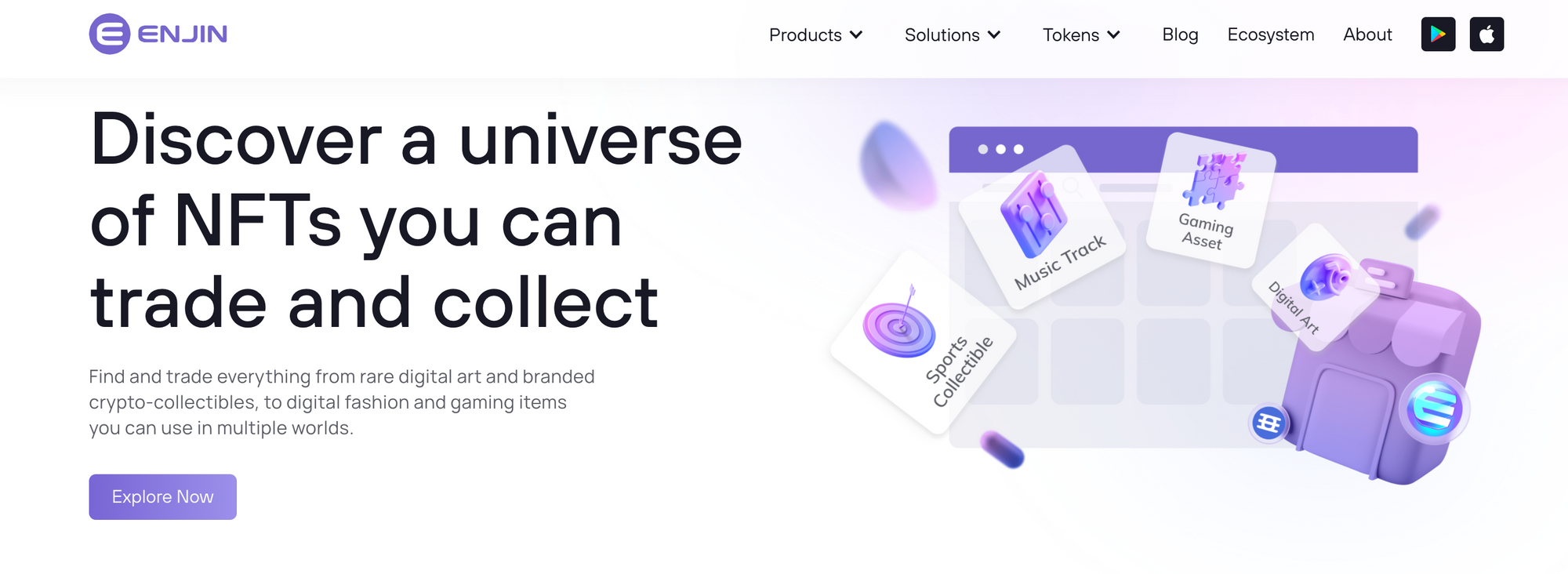
- Enjin
JumpNet, a private version of the popular Ethereum blockchain, can be used to mint NFTs via Enjin. The platform has its own token Enjin Coin (ENJ), which it can charge for minting.
So to get started with Enjin NFT minting, you may require your little ENJ fund. However, one ENJ token currently costs less than two dollars, so you won't have to break the bank.
Enjin does not charge any gas fees for minting, which is a big advantage compared to Ethereum. However, it's worth noting that Enjin is more geared toward gaming NFTs than art NFTs, so if you're seeking an art NFT-focused experience, you might want to explore elsewhere.
2. Binance Smart Chain
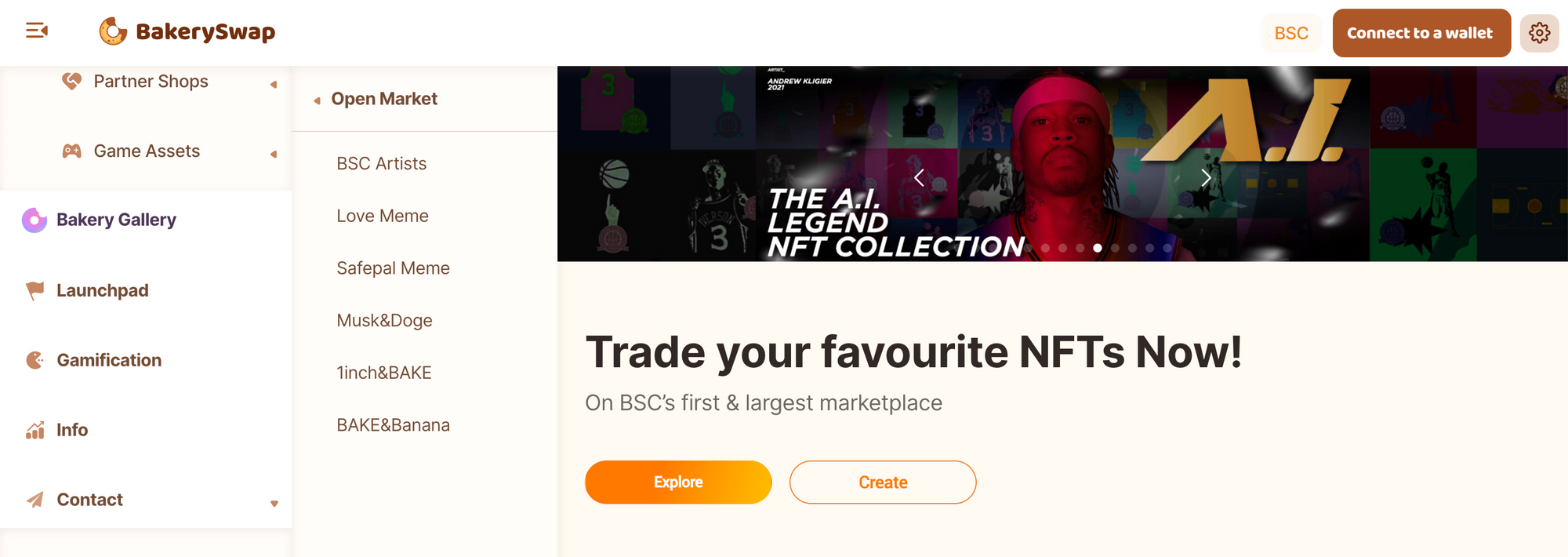
Binance is a well-known platform with its world-famous crypto exchange handling billions of dollars in cryptocurrency trades every week. However, Binance is more than just a cryptocurrency exchange. You may mint NFTs with the Binance Smart Chain (or BSC), which operates alongside the original Binance blockchain.
BakerySwap and AirNFTs are two DApps you can use on the BSC to mint your NFTs. However, before you get started, have a look at the many minting platforms available to see which one is ideal for you.
Minting with the BSC isn't free, but it's a small price to pay. It currently costs 0.05 BNB for each mint, which is about $2.60. So, minting NFT on the Binance Smart Chain won't cost you much, but you may do it for free on other platforms (usually via lazy minting).
On top of the minting fee, Binance charges a 2.5% service fee if or when your NFT is acquired. Despite the inconvenience of these two payments, unlike many other minting platforms, the BSC has negligible gas fees.
3. Rarible
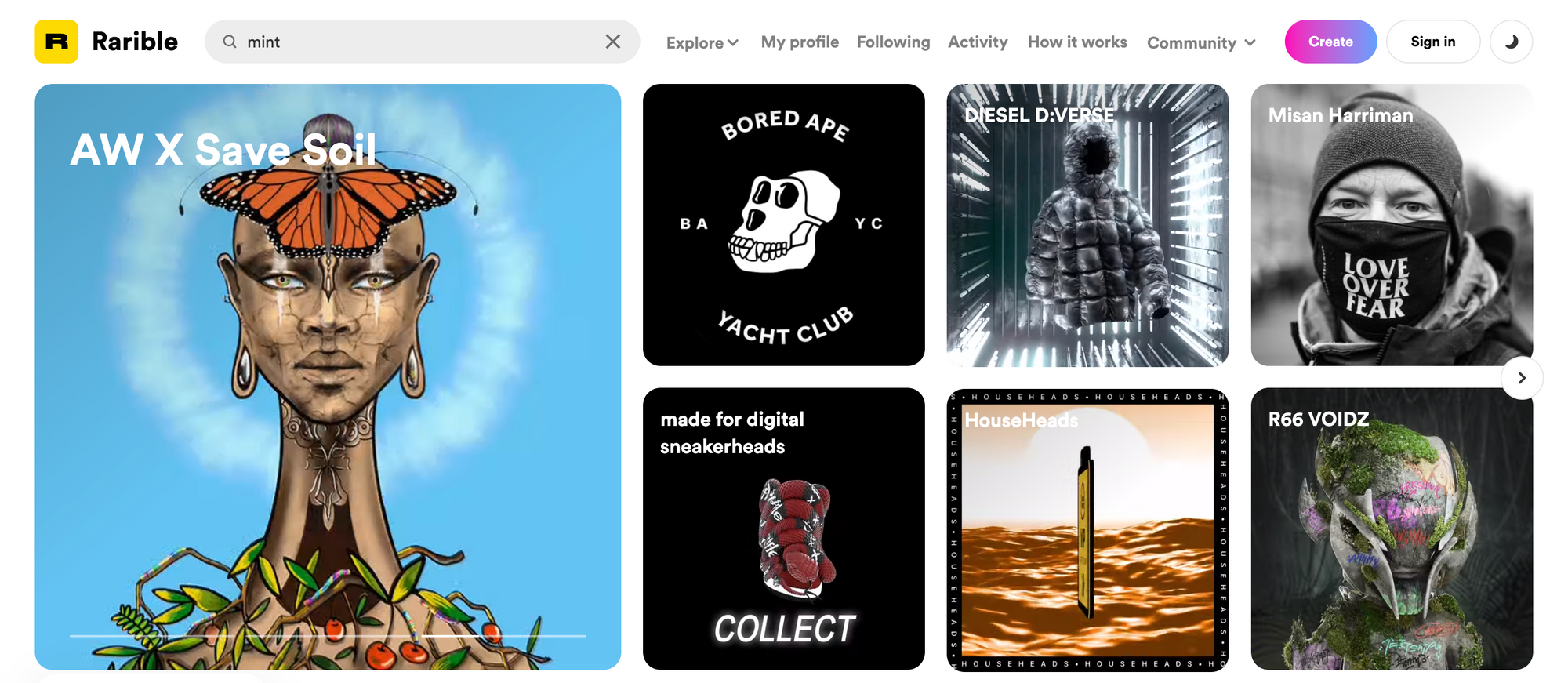
Rarible is a popular NFT platform frequently used as a replacement for OpenSea (which is coming next in this list). While Rarible may not have the same level of traffic as OpenSea, it is still a viable choice for minting and selling NFTs. It also features a nascent community section where NFT fans can get together.
The minting method used by Rarible is known as "lazy minting". In this method, your NFT will be minted only if someone agrees to buy it. It is a more environmentally responsible manner of minting digital assets. And it also costs artists a lot less — you can mint your NFT for free using Rarible's lazy minting tool.
4. OpenSea
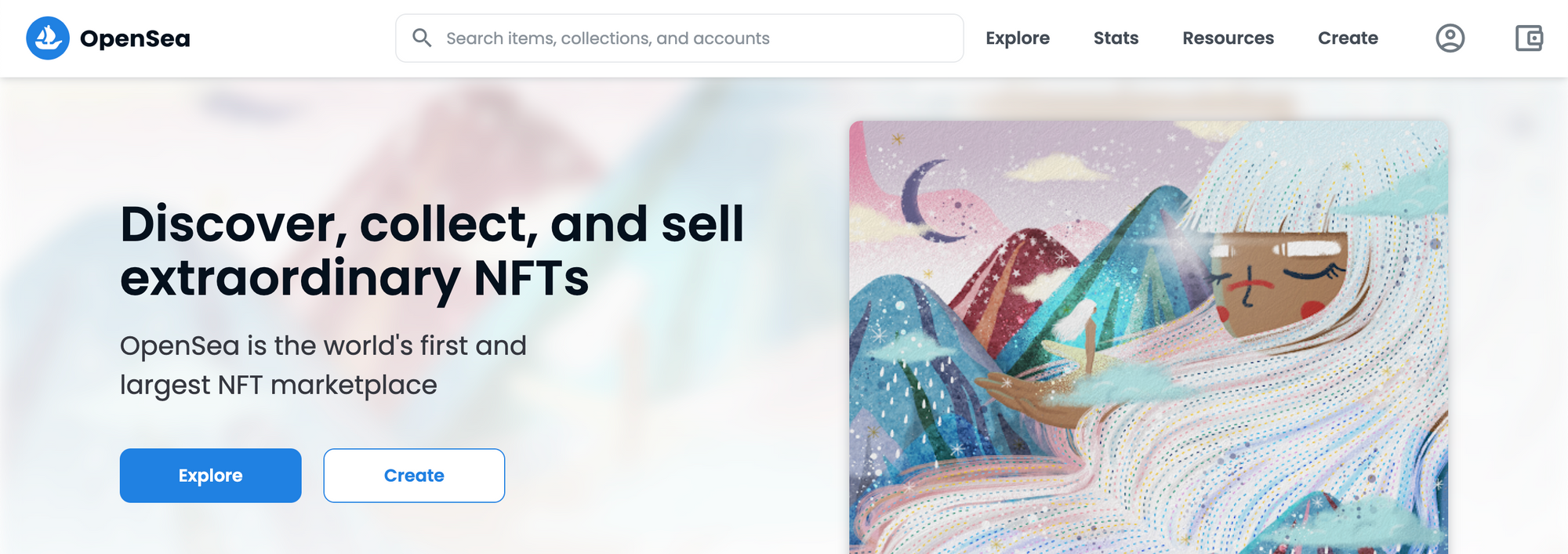
We've already discussed this one. OpenSea brings all things NFT together in one spot. You may purchase, trade, develop, and mint digital assets with OpenSea. And, considering how big OpenSea has gotten, it's undoubtedly one of the finest venues to sell an NFT.
Because OpenSea offers the most popular and diverse NFT marketplace, it's also a good place to mint your NFT.
Although there is no fee for minting, OpenSea takes a 2.5% cut of the price your NFT sells for. It's also worth noting that, like Rarible, OpenSea allows for lazy minting, which means your NFT won't be actually minted until someone buys it.
OpenSea also has relatively high gas fees for each transaction. These are charges that users must pay to run smart contracts that underpin OpenSea's platform.
5. Proton Mint
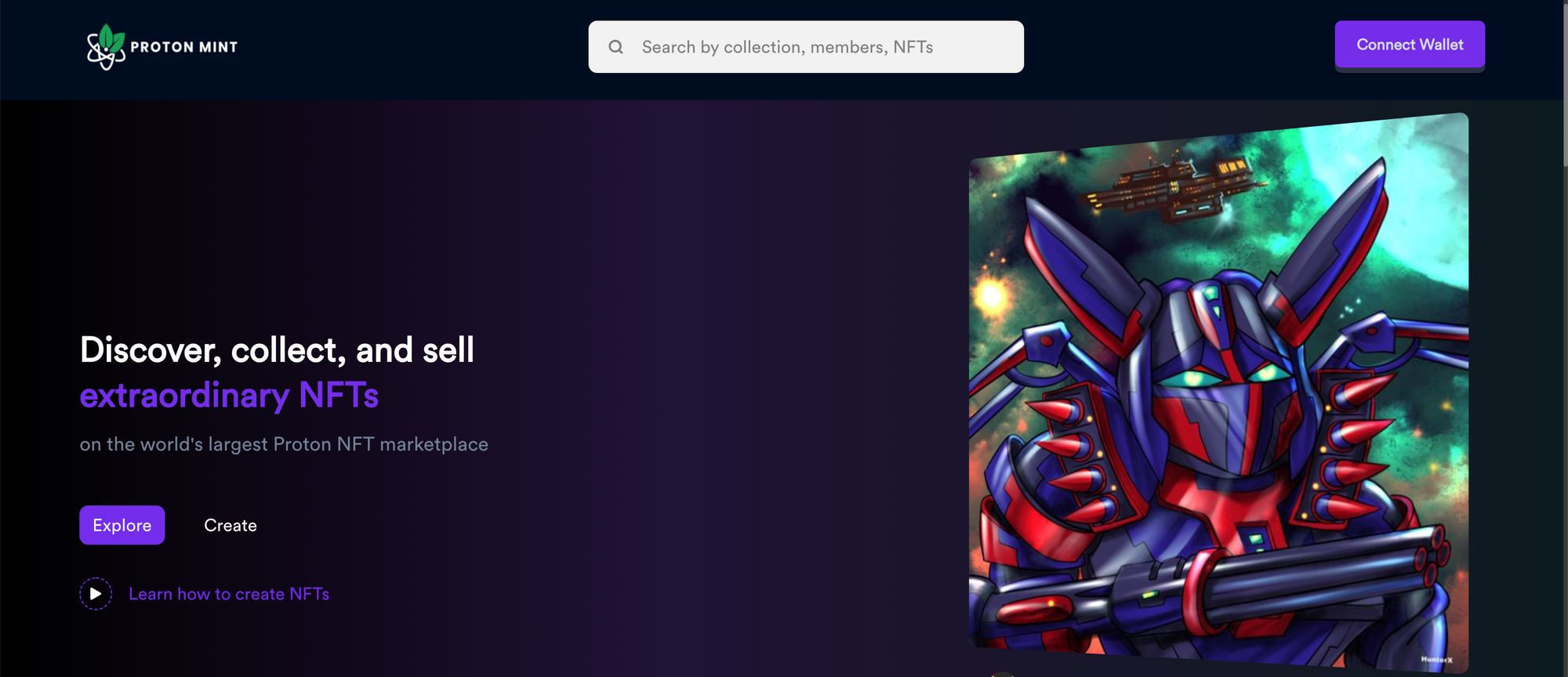
Another fantastic solution for minting NFTs is the Proton Mint marketplace. One of the best aspects of Proton Mint is that there are no gas fees associated with minting. You can mint your first NFT for free, and further NFTs are inexpensive. The website also has an excellent user interface, making it simple to get started with NFTs.
BSC, Ethereum, and Stellar are just a few of the blockchains supported by Proton Mint. If you're interested in investing in NFTs, Proton has a diverse marketplace where you can locate some incredible digital assets. If you wish to link a wallet to the site, this is also an option, albeit your options are restricted to Proton Wallet and Anchor Wallet.
How to Create an NFT
You can create a digital art token by carefully following the steps below:
Step 1: Choose an NFT Marketplace
This is the most essential and initial step in creating your NFT artwork. There are two categories to choose from:
- Curated platforms: Only authorized artists can mint or manufacture digital art tokens in this NFT marketplace category. They're primarily interested in high-quality digital art tokens rather than low-quality memorabilia.
SuperRare is an example of a curated NFT marketplace. To start selling their NFTs, artists must pass through the application process. This vetting process ensures high quality of art and more attention to each individual artist. Unfortunately, SuperRare charge significantly higher transaction fees and provide you with less choice regarding the royalty rates you can set for your artwork.
- Self-Service Platforms: These marketplaces allow anyone to make their own NFT. You can use a photo, a movie, or an audio file to create your own. You can also charge whatever royalty you want on each secondary sale of your tokens.
This category includes platforms such as OpenSea and Rarible, the two platforms we've already discussed. One drawback of open platforms is that unfortunately, there are often too many imitators and fraudsters on these NFT marketplaces.
After you've decided which marketplace to use and created an account with it, it's time to go on to the next stage. Because this is a beginner-friendly essay, the marketplace OpenSea will be used as an example of how to create your digital arts token.
Step 2: Set Up a Crypto Wallet
The next step is to create a crypto wallet to store your money and NFTs. Yes, cryptocurrencies, usually ETH, are necessary to build NFTs.
It would be beneficial if you owned some ETH because the most valuable NFTs exist on the Ethereum network. You will also need to pay the gas fee for any Ethereum transaction, including for minting any token you've created.
OpenSea recommends installing the MetaMask cryptocurrency wallet's Google Chrome plugin, buying ETH, and getting ready to mint NFTs.
Let's assume, however, that you have an Ethereum wallet already, for example at a crypto exchange. In that case, you can create a MetaMask wallet and move the ETH from your old wallet to your new MetaMask.
The cost of gas for minting an NFT range from $10 to $200 in ETH. So, if you have enough money, you can go to the next step.
Step 3: Create Your NFT Collection
Go to OpenSea and click on the wallet icon in upper right corner to connect your crypto wallet. You will need to sign a message with your wallet — this acts as a login.
Then, click on the circle next to the wallet icon — that's your profile. "My Collections" will appear on your OpenSea account's interface; click it. It functions as a digital art store or gallery.
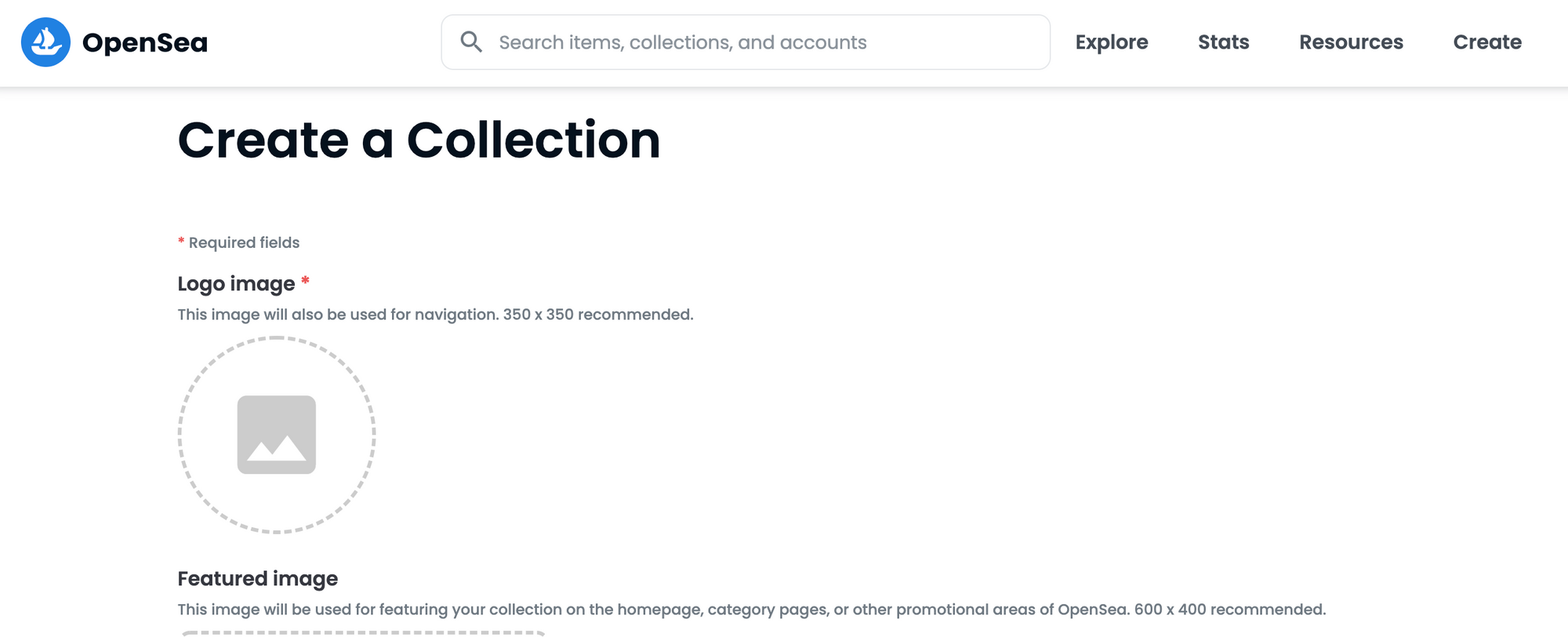
Now you must name your collection, provide a description, and upload a display image. This lays the basis for displaying your artworks once they've been completed.
Step 4: Creating Your Digital Art Token
It's time to start the primary process of producing your NFT once you've completed your collection.
When you click "Add New Item", you'll be given a choice to add metadata, such as visual (JPG, PNG, GIF, etc. ), audio (MP3, etc. ), and 3D files (GLB, etc.), as well as giving your token a name.
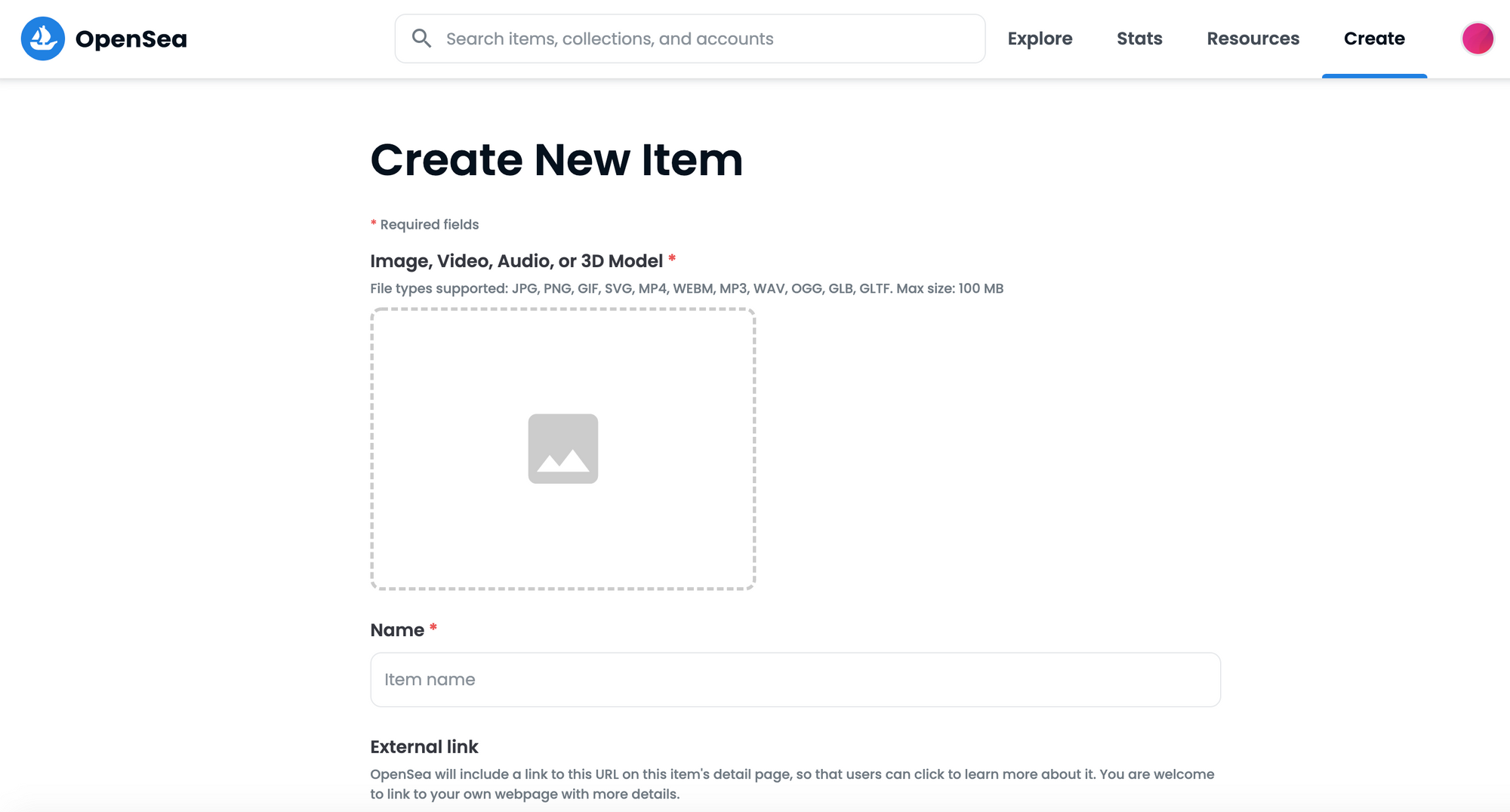
You can mint a limitless amount of tokens, but you must do so one by one. So it's also crucial to think about how many different copies of the same token you'd like to make.
- Stand-alone Token: also known as 1:1, this means you can only make one replica of that specific digital art token, potentially increasing its value.
- The Edition Tokens: You can make as many duplicates of the identical token as you want. To differentiate between each copy, add the edition number.
Then, where appropriate, you may add attributes, levels, and analytics to help customers sort your artwork as they browse your collection. The date when you produced the token is one example of a property.
Click "Create" to add your NFT to the blockchain. This step will require ETH to pay for approval and gas fees.
After that, you may select which payment tokens you want to accept for your digital work. You can also choose how much of a royalty you want to get from secondary sales of your artwork.
Step 5: Listing Your Artwork For Sale
After you've finished creating your NFTs, you'll need to sell them. Again, you can select between a fixed-price listing and an auction where you decide the price yourself.
You must pay gas fees before listing your artwork if this is your first time creating and selling an NFT.
Step 6: Promote Your Work On Social Media
You'll need to acquire a sizable fanbase to increase your chances of selling your work. As a result, you should share your direct link with potential purchasers and advertise your artwork on social media to help people find it.
How to buy an NFT
Step 1: Create a Crypto Wallet
You'll need a cryptocurrency wallet to buy and hold NFTs. MetaMask is a popular choice.
Step 2: Fund your wallet with Ether (ETH)
Once you've created your wallet, you'll need to buy some ETH. You can either do this directly in MetaMask (just click 'buy' to see available options) or first buy ETH on a crypto exchange and then transfer it to your MetaMask wallet.
Step 3: Browse NFTs on Zerion
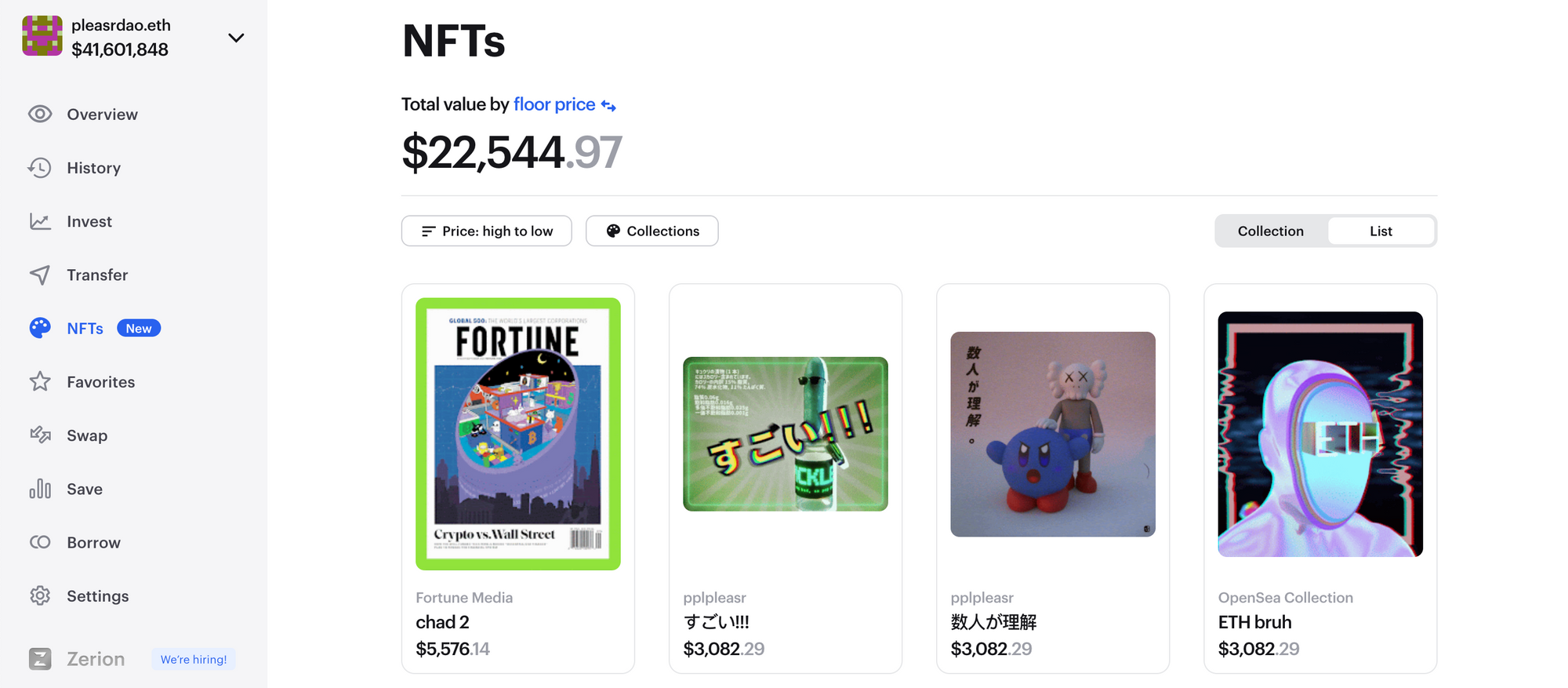
Go to Zerion and connect your MetaMask wallet. After that you'll be able to browse NFTs owned by any address, for example by leading collectors like PleasrDAO or Cozomo_de_Medici aka Snoop Dogg.
Step 4: Buy NFTs on a Marketplace
Once you find on Zerion an NFT you like, you can click one of the links under a token to buy it on Rarible or OpenSea. See those links at the bottom?
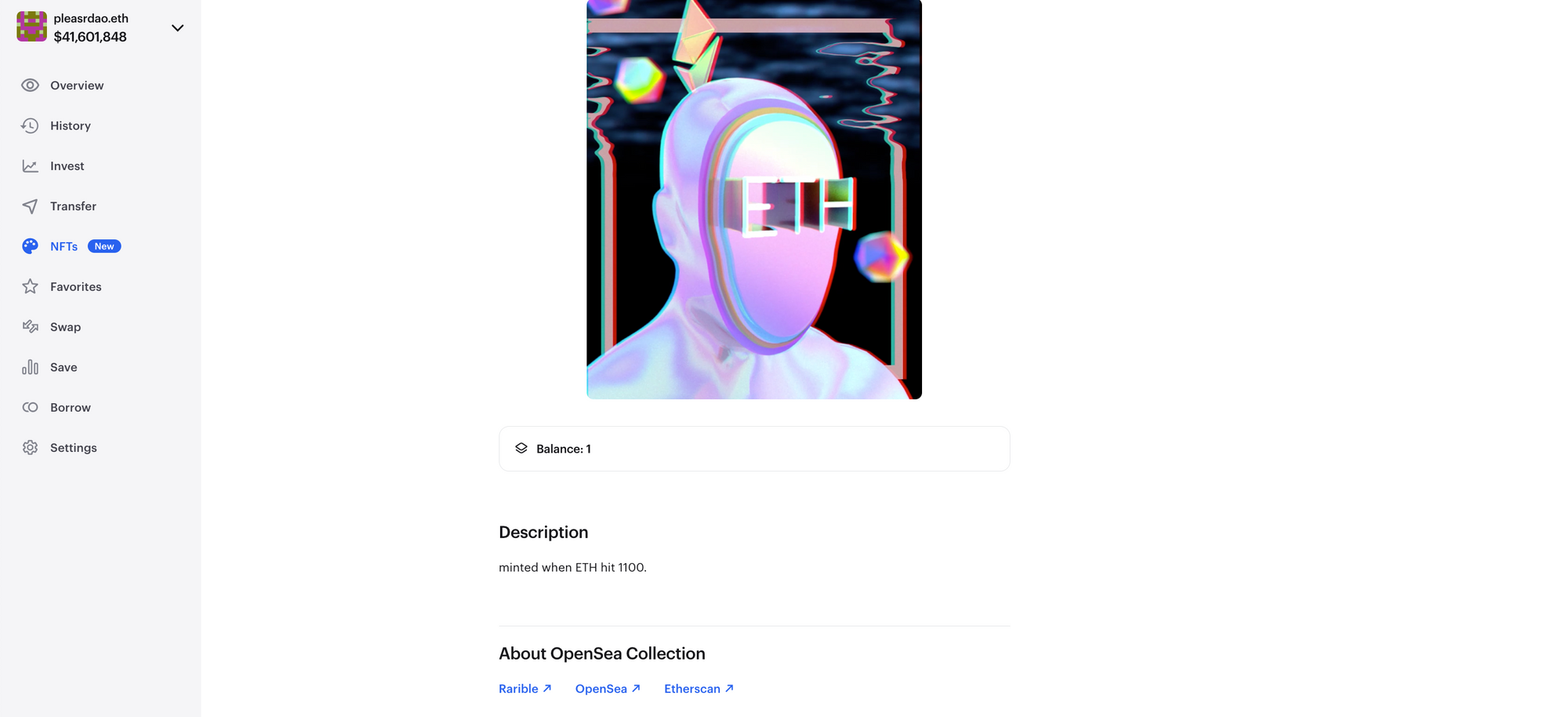
How to sell an NFT
Step 0: Install MetaMask Wallet or Other Wallet
If you have some NFTs to sell, we'll assume that you already have a crypto wallet. If that's not the case, you'll first need to create a wallet like MetaMask.
Step 1: Fund your wallet with Ether (ETH)
You'll need some ETH to pay for gas fees to list and sell your NFT. You can buy it directly in MetaMask or buy on a crypto exchange and then transfer to your wallet.
Step 2: List your NFT
Go to OpenSea and click through to your profile and select the NFT that you want sell. In the upper right corner you'll see the 'Sell' button; click it.
Then you'll need to select the price, data, and other settings for your sale.
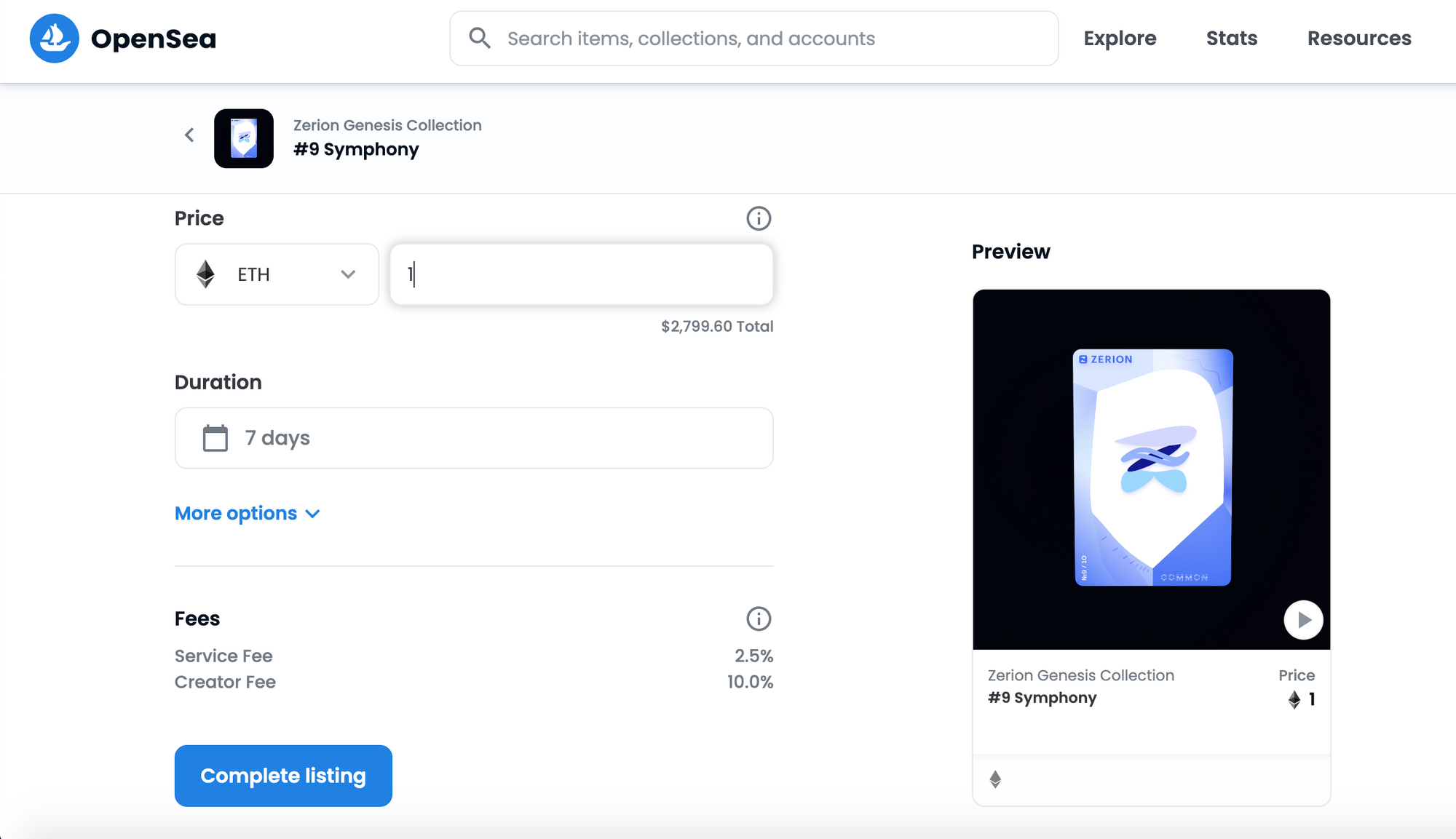
Finally, click 'Complete listing'. You will be asked to sign several transactions to confirm the listing and authorize OpenSea to sell the item — keep in mind that this costs gas. And after all signed, your NFT is listed. Now you just need to wait for the buyers!
FAQ
Can I create my own NFT?
Yes! You can create your own NFTs on Rarible or OpenSea using the instruction we've outlined in this article.
How much does it cost to make an NFT?
The costs of making an NFT are frequently determined by two things: the minting site fees and the gas fees. However, you should be able to list your NFT for less than $300 in most circumstances. Some sites, though, will let you list it for free.
Is it free to create an NFT?
Typically, you must pay gas fees for creating NFTs. However, with "lazy minting" on OpenSea and Rarible, you can create NFTs "for free" — or at least you won't have to pay gas fees until someone buys your NFTs.
What app can I use to create NFT?
As we've shown above, you can use OpenSea or Rarible to create your NFTs. There are also plenty of other platforms to choose from and new NFT marketplaces are launching all the time.
Can I make money on NFT?
Creators can specify terms that impose royalty fees anytime their NFTs change hands on the secondary market. As a result, as a creator, you can earn from NFTs long after you have sold them.
Making money as an NFT collector and trader is not easy. You need to have a good eye for what's trendy to spot up-and-coming NFTs and know exactly when to sell them.
How do I market my NFT?
While there is no easy way to market an NFT, many projects do something like this;
- Fill up NFT calendars with your drop.
- Make use of your social media platforms.
- Make a captivating teaser for your NFT project.
- Get into the marketplace's featured drops.
- Solicit the support of your friends and coworkers for your release.
- Make a thread on Reddit/Bitcointalk about it.
Can a photo be an NFT?
Yes, you can tokenize a photo, some code, message, or anything else as an NFT.
What makes a good NFT?
Successful NFT initiatives have healthy communities that support them. NFT holders are more than just art collectors; they are members of a group in which a culture has developed and breeds a following.
Where can I sell NFT for free?
If you use Mintable Marketplace or the Polygon Network on Opensea, you can list an NFT for sale without paying any fees (even if you have 0 ETH in your wallet).
Are NFTs real art?
NFT is a new technology that gives artists new ways of expressing themselves. So NFTs can be collected in the same way that photographic prints can be. Both photographers and NFT artists of all abilities and genres are now able to market and sell their work in a new way.
What NFT art sells best?
Rare NFTs fetch sell at the highest prices. A computerized collage of works by Beeple sold for $69.3 million at a Christie's auction, making it the most expensive NFT. Alien Cryptopunks, a collection of one-of-a-kind pixel art developed by Larva Labs' algorithms in 2017, are also among the most expensive NFTs list.
Why is NFT art so expensive?
First, remember that each NFT is one-of-a-kind and serves as a collector's item that can't be copied, making them rare by design. If many wealthy collectors compete to buy these NFTs, their prices rise. However, most NFT artworks are not that expensive.

